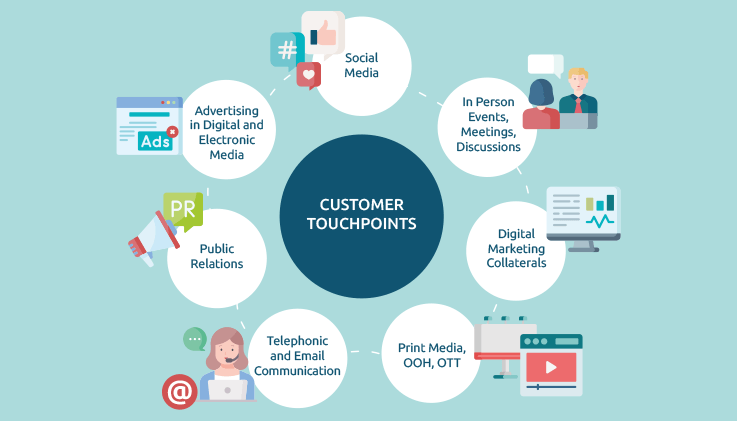Serving customers and being a part of their journey is an aspiration for businesses worldwide. Companies are always alert and spend billions of dollars to serve customers. No stone is left unturned to ensure the right message for the product goes out to them at the right time and on their chosen platform. This helps brands to reach their ultimate objective of providing a rich customer experience (CX). When you have your customers’ best interests in mind at each touchpoint, then you are capable of providing great CX.
Customer touchpoint - another CX-related jargon?
A customer touchpoint isn’t another jargon word in the vibrant and ever-evolving CX realm. Whatever way your customers are connected to you, a customer touchpoint encompasses everything that happens in the customer journey/lifecycle. The breadth of customer touchpoints’ value proposition fuels the passion of those passionate about CX, irrespective of their industry. Customer touchpoints are all points of contact between a business and customer, from start to finish. It includes all online and offline interactions customers experience with a brand throughout their journey.
Who needs to be aware of customer touchpoints?
Everyone in your organization who interacts with customers from start to end in their lifecycle needs to think of it as a scientific process. Break down the fundamental components of a customer’s journey, apply a fresh perspective to understand their problems, and map the properties of every touchpoint to see how much they have helped the customer reach a comfortable solution.
According to consumers, everything from their contact as potential customers with the brand through marketing and advertising to their interaction as active users during the purchase (digitally or physically) to the time they seek service and beyond are customer touchpoints. These touchpoints can influence consumers and affect their journey into your sales funnel.
Guiding principles for providing great customer touchpoints
You should look at the customer lifecycle from their point of view and answer the following questions.
- What do customers want to do, and what are they looking for?
- What is the experience you wish to create?
- How can you improve or enhance the experience?
Scenario: You’re browsing social media, scrolling through various posts, when suddenly, you see an advertisement for your favorite merchandise on sale. You browse through the merchant’s profile and glance through the various products on the social channel. That’s product discovery happening right there.
Afterward, if you are attracted to what’s on display, you go to the merchant or eCommerce website/app and make the purchase. In this case, the social channel and the various types of content that help the customer discover the product, keep them engaged with the brand, and fulfill the purchase comprise customer touchpoints.
Also read: 360-Degree Visibility: Tracking Customer Behavior Across Touchpoints
How customer touchpoints impact your organization – a practical perspective
Customer touchpoints are the deciding factor for consumers in their journey with you. Every phase of your relationship involves touchpoints. Here’s what you need to know to plan and create moments that strengthen your customers’ bond with you.
Stages of customer journey influenced by touchpoints:
- Brand Awareness: Touchpoints are assets used to attract consumers' attention to your product, cause, or brand. Examples include advertisements in electronic, print, and digital media, social media posts, specialized content like quizzes, polls, marketing campaigns, etc.
- Discovery: Everything that helps consumers find you. Examples: Interactive kiosks at fairs and trade shows, websites, banner ads, brochures, contact us, emails, etc.
- Engagement: Everything that helps the customer remain engaged with you. Examples: social channels, social commerce, online marketplaces, in-store experiences, experience centers and showrooms, quotes/proposals/Letters of intent, and websites. Marketing and sales pitches, communications, CTA, product demonstration/free trial, specifications comparison. masterclasses, hands-on experience, and every other asset mentioned in the examples above.
- Conversion: Assets that help the consumer progress into your sales funnel and become an active client. Examples include all the assets mentioned in the above-mentioned customer lifecycle stages.
- Satisfaction: Consumers are generally satisfied with the sales and billing experience, the product, and the after-sales service. Product and spare parts warranty and guarantee, service network, service quality, and value for money greatly influence this stage of a customer’s journey. Along with these factors, all the asset examples of customer touchpoints mentioned above continue to influence their journey.
- Experience: Your mission to provide seamless and omnichannel touchpoints to consumers and the effort you put in culminate in this stage of your customer's journey. You hope that this stage remains a continuous affair. Indeed, that is made possible by the sum total of experiences your customers had across all touchpoints they encountered during their association with you. How can you measure that?
- Close the loop: This is yet another crucial touchpoint that truly helps you achieve the heights of CX. Closing the loop entails collecting feedback from your customers about your product, service, and their overall experience of being associated with you and working on them. Here, your customers’ experiences of the touchpoints and your sincerity towards them can truly make or break your results.
Understanding and working on your customer touchpoints can help you identify the root causes of ongoing customer issues and opportunities for improvement. You should continually review and visit touchpoints to ensure you keep refining your offerings. If done right, this can help you deliver better CX, which further cements your relationship with consumers. Sign up for a 30-day free trial to discover advanced ThinkOwl tools that ensure awesome CX for your customers.
